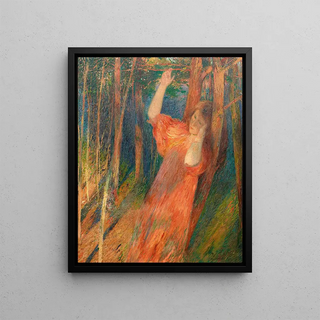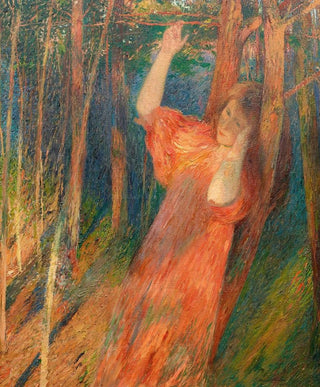Art print | Autumn Daydream - Henri Martin Source: Reproduction | Rêverie automnale - Henri Martin


View from behind

Frame (optional)
In the vast panorama of art history, some artworks manage to capture the essence of a season, an emotion, or a fleeting moment. "Art print Autumn Reverie - Henri Martin" is one of those pieces that delicately evoke the magic of a golden autumn. Through this canvas, the artist invites us to immerse ourselves in a universe where nature is adorned with warm colors and where each brushstroke seems to whisper the secrets of a season in full transformation. This piece, both contemplative and vibrant, embodies a moment of serenity, a suspended instant between dream and reality. The shimmering hues and play of light transport us to a landscape where the ephemeral beauty of nature is celebrated.
Style and uniqueness of the work
Henri Martin, master of pointillism, developed a style that is uniquely his own, combining finesse and brilliance. In "Art print Autumn Reverie," he uses juxtaposed touches of color to create an effect of depth and luminosity, offering an almost impressionistic view of nature. The trees, with their fiery leaves, seem to dance in the gentle breeze, while the sky is tinged with orange and golden shades, evoking the softness of an autumn afternoon. Every element of the composition is carefully arranged, demonstrating undeniable technical mastery. The harmony of colors and the lightness of forms give the artwork an atmosphere of reverie, where the viewer is invited to immerse themselves in an idyllic landscape, far from the tumult of everyday life.
The artist and his influence
Henri Martin, born in 1860, is often regarded as one of the most prominent representatives of pointillism, a movement that marked the end of the 19th century. His artistic journey is punctuated by decisive encounters, notably with figures like Georges Seurat and Paul Signac, who shaped his vision of color and light. Martin mastered the principles of pointillism while adding a personal touch, blending influences from Impressionism with his own sensitivity. Throughout his career, he explored

Matte finish

View from behind

Frame (optional)
In the vast panorama of art history, some artworks manage to capture the essence of a season, an emotion, or a fleeting moment. "Art print Autumn Reverie - Henri Martin" is one of those pieces that delicately evoke the magic of a golden autumn. Through this canvas, the artist invites us to immerse ourselves in a universe where nature is adorned with warm colors and where each brushstroke seems to whisper the secrets of a season in full transformation. This piece, both contemplative and vibrant, embodies a moment of serenity, a suspended instant between dream and reality. The shimmering hues and play of light transport us to a landscape where the ephemeral beauty of nature is celebrated.
Style and uniqueness of the work
Henri Martin, master of pointillism, developed a style that is uniquely his own, combining finesse and brilliance. In "Art print Autumn Reverie," he uses juxtaposed touches of color to create an effect of depth and luminosity, offering an almost impressionistic view of nature. The trees, with their fiery leaves, seem to dance in the gentle breeze, while the sky is tinged with orange and golden shades, evoking the softness of an autumn afternoon. Every element of the composition is carefully arranged, demonstrating undeniable technical mastery. The harmony of colors and the lightness of forms give the artwork an atmosphere of reverie, where the viewer is invited to immerse themselves in an idyllic landscape, far from the tumult of everyday life.
The artist and his influence
Henri Martin, born in 1860, is often regarded as one of the most prominent representatives of pointillism, a movement that marked the end of the 19th century. His artistic journey is punctuated by decisive encounters, notably with figures like Georges Seurat and Paul Signac, who shaped his vision of color and light. Martin mastered the principles of pointillism while adding a personal touch, blending influences from Impressionism with his own sensitivity. Throughout his career, he explored






